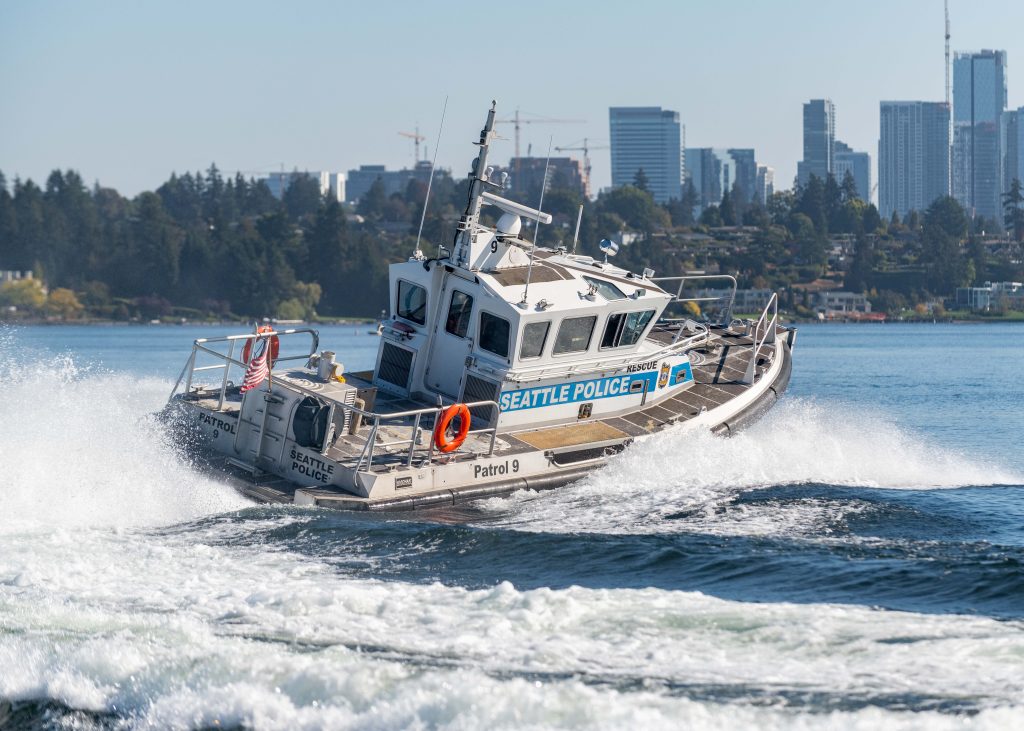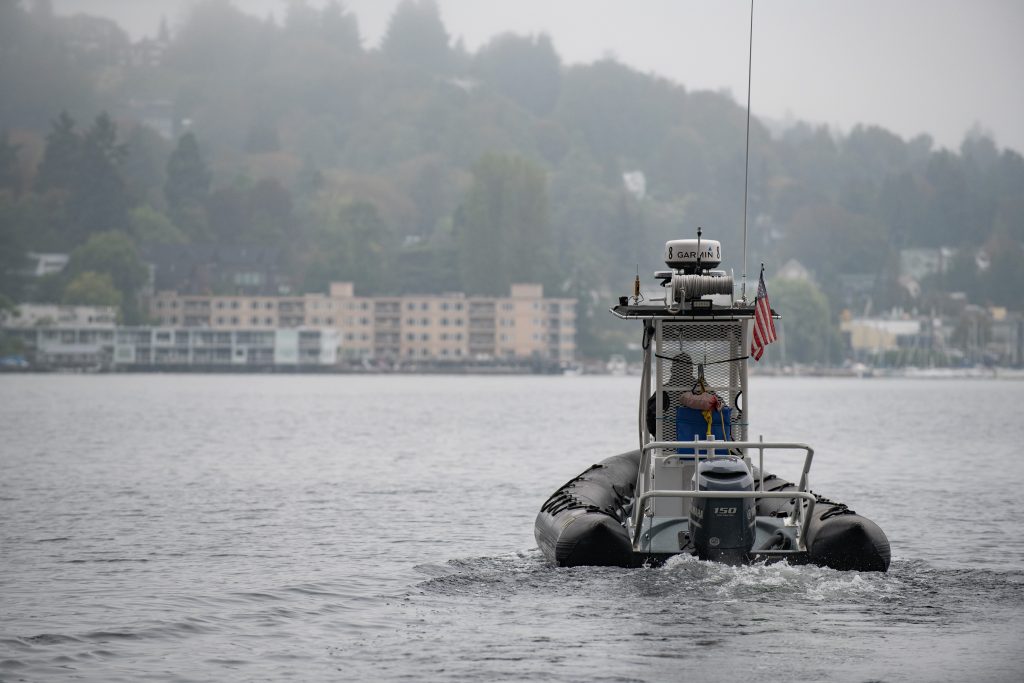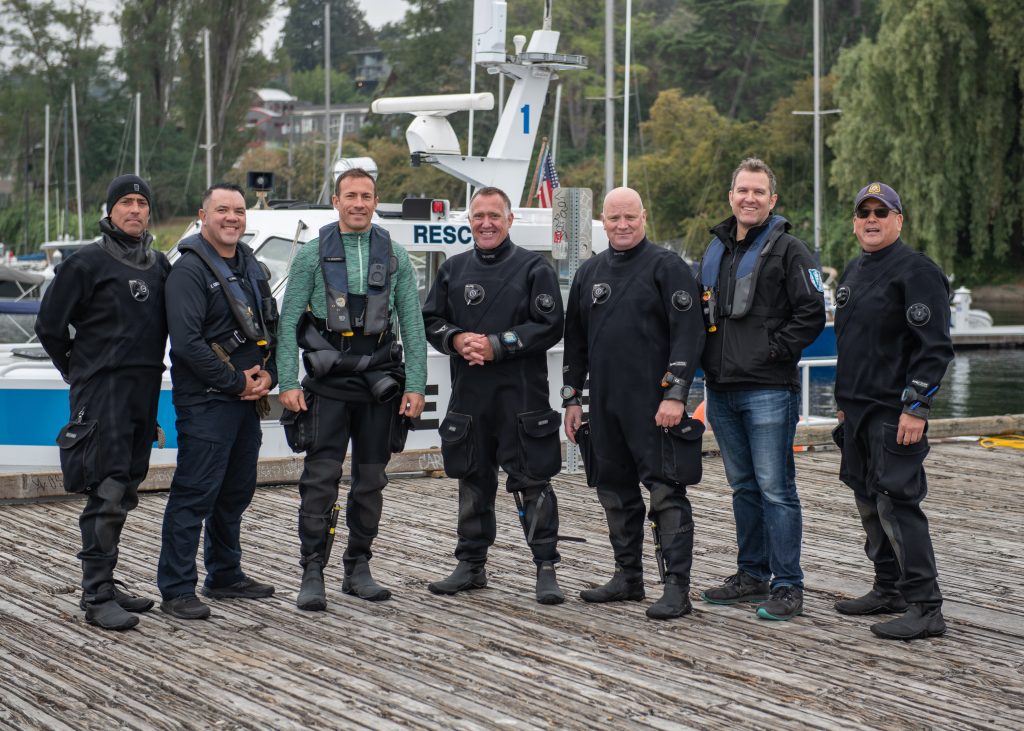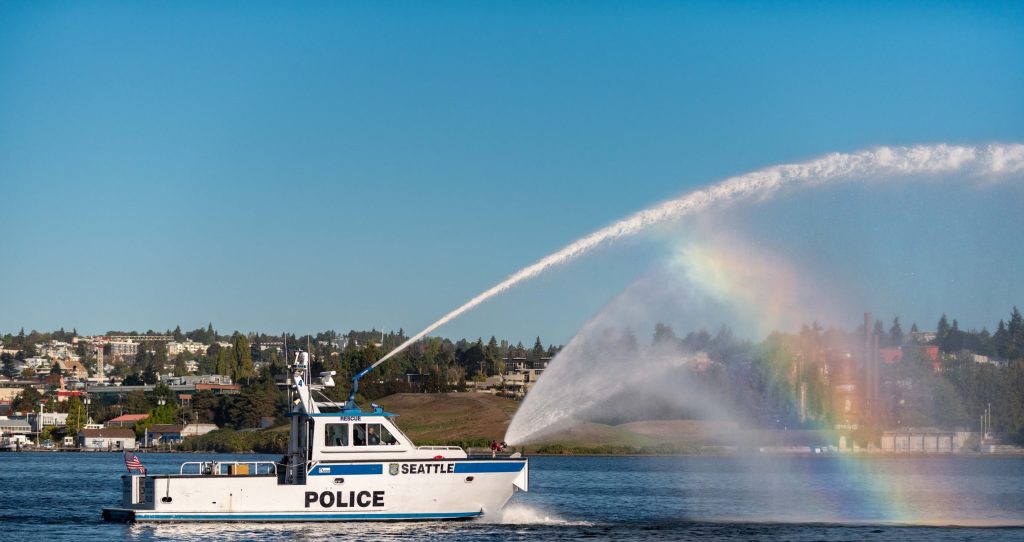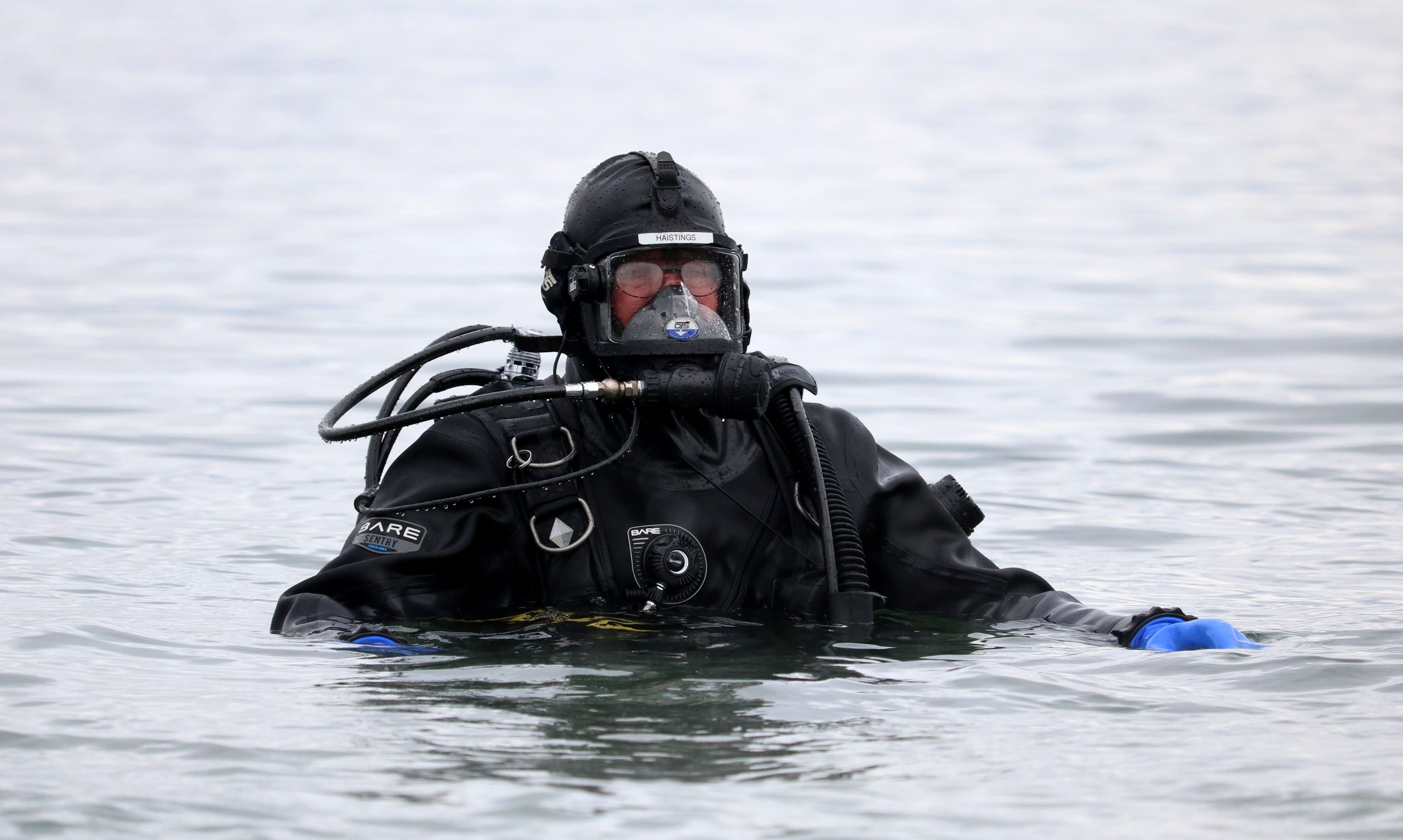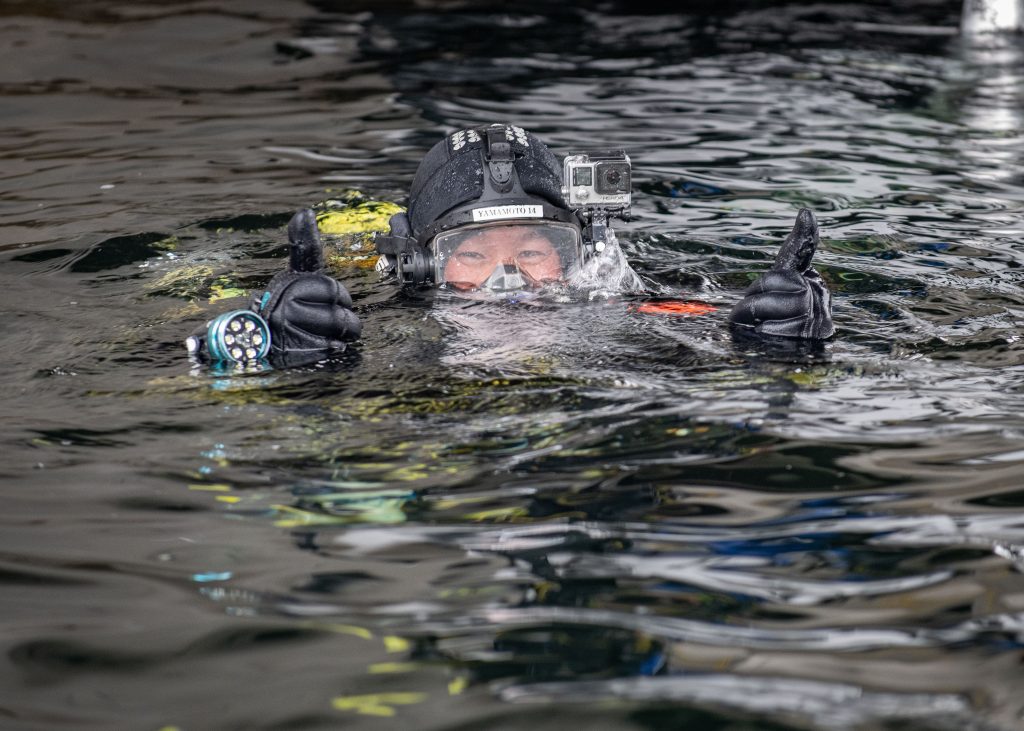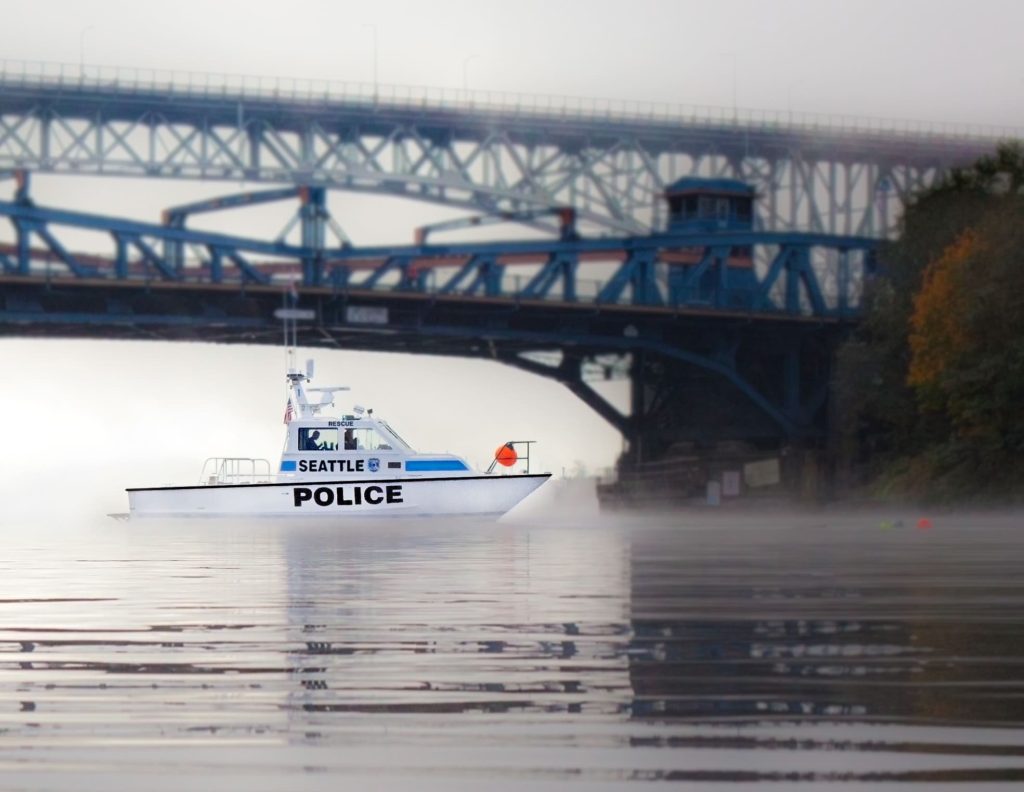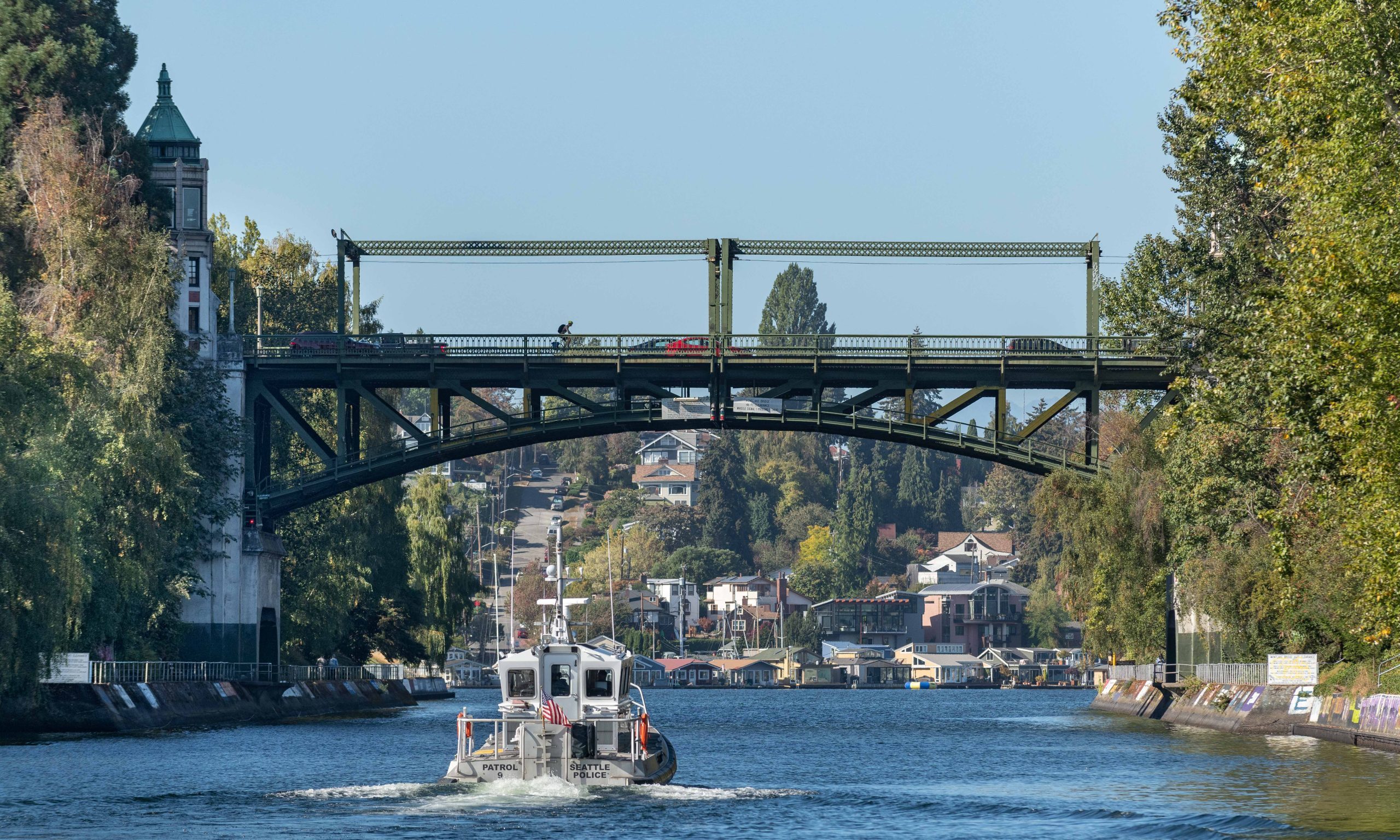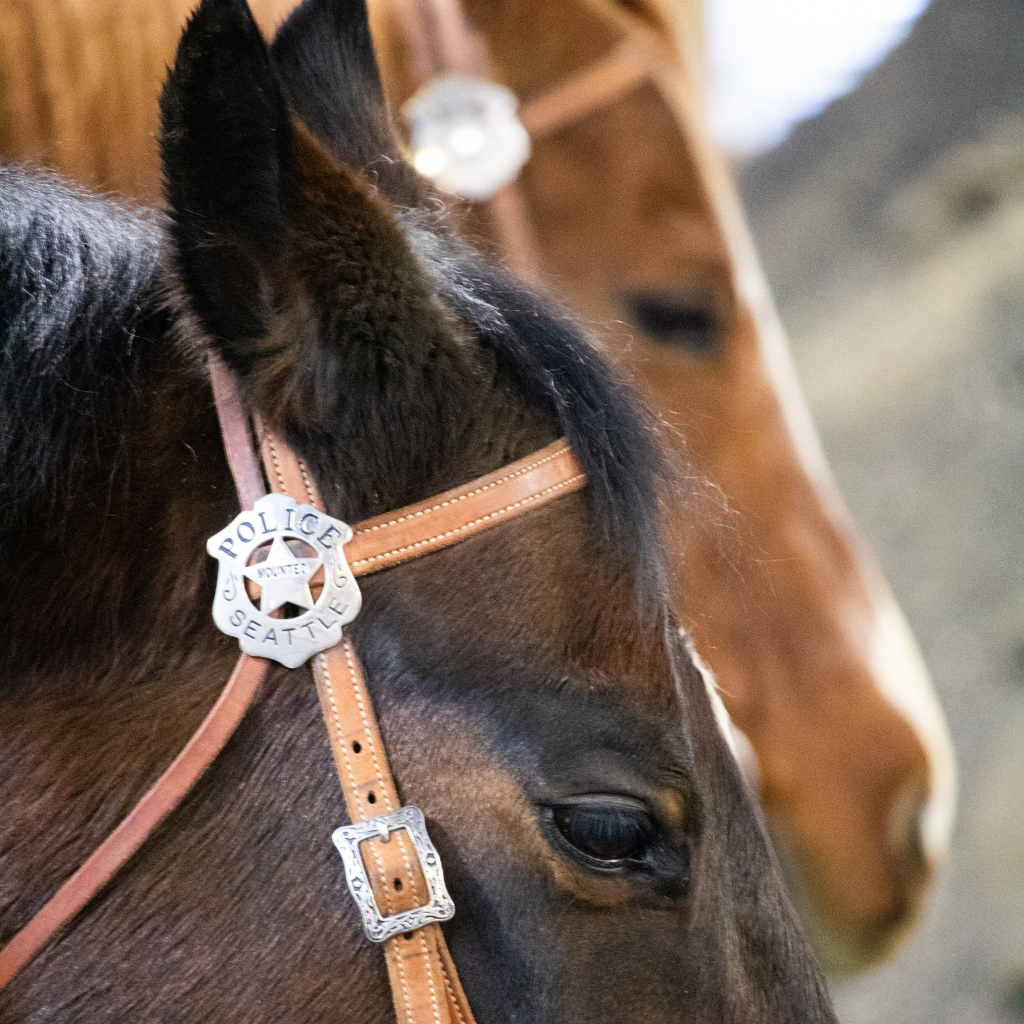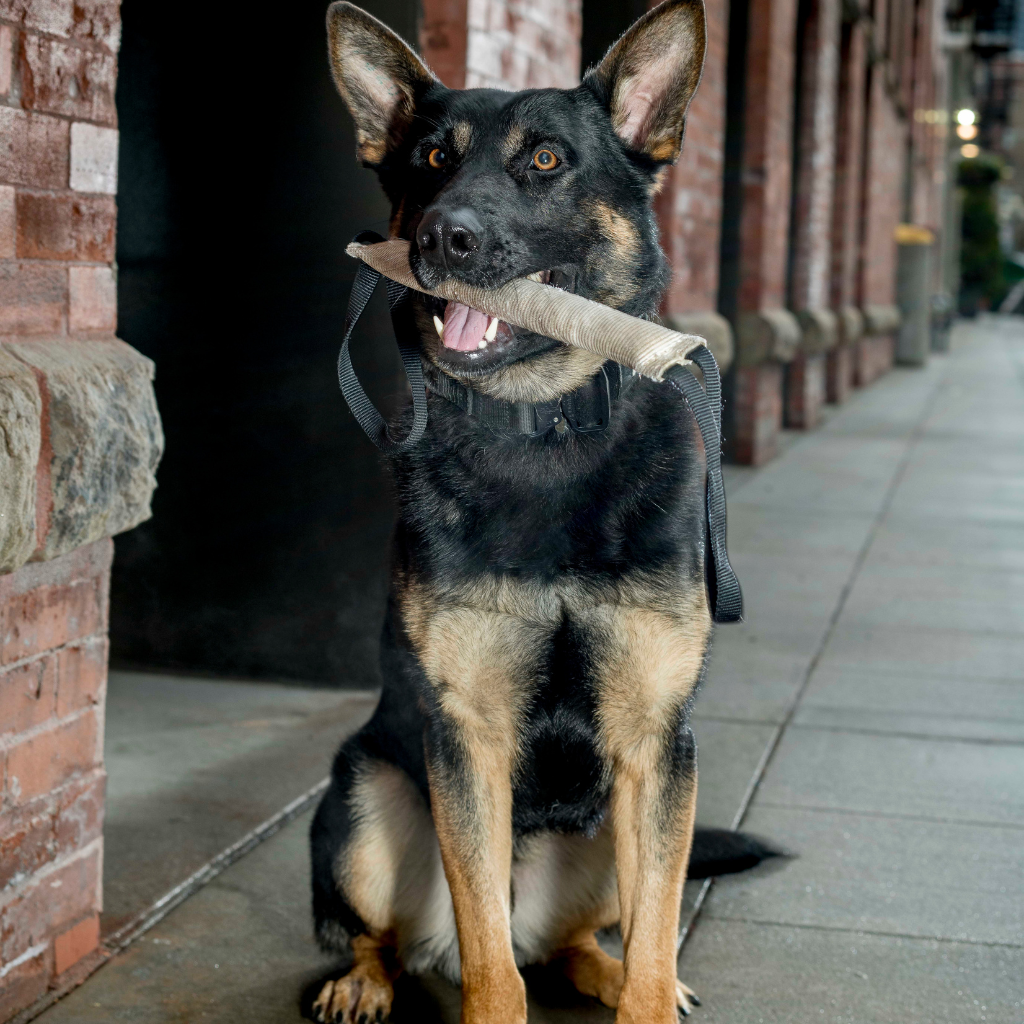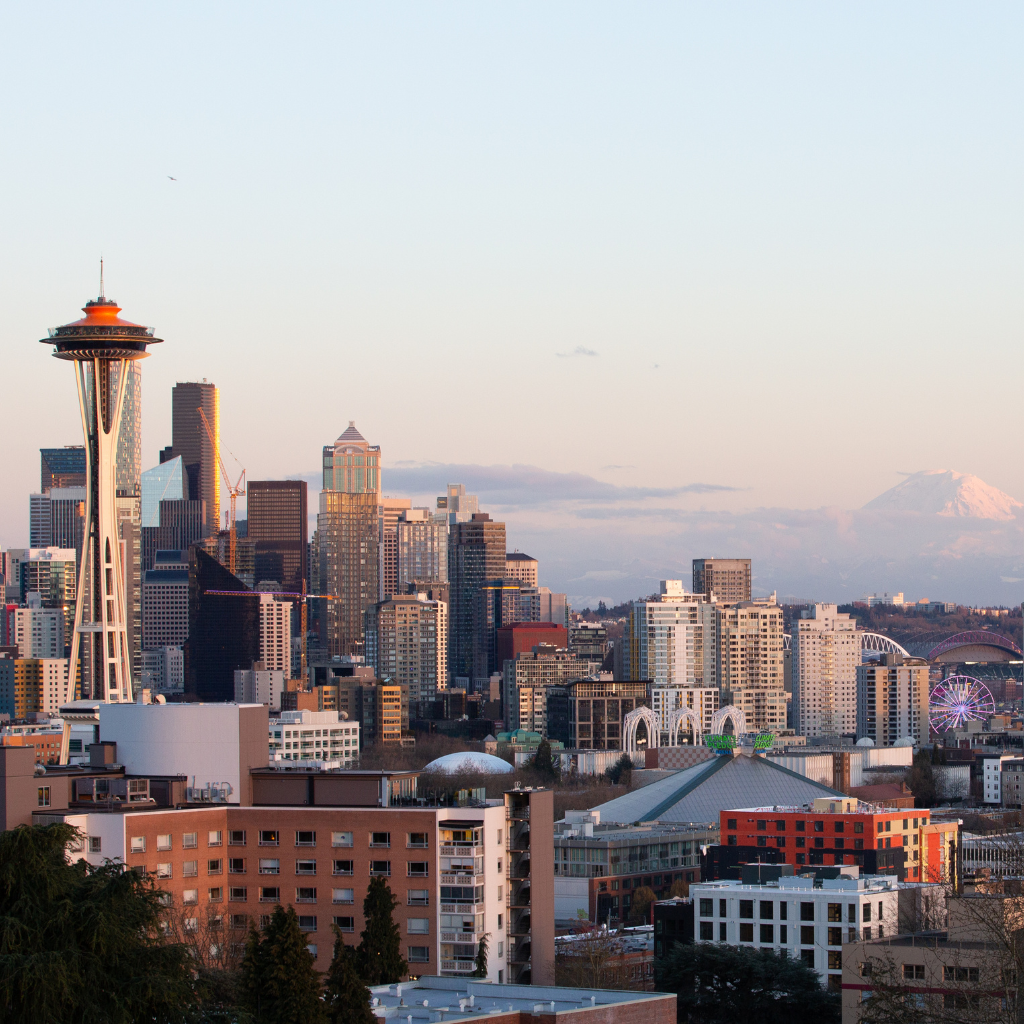Harbor Patrol
Harbor Patrol
Thank you for your support in 2023! Thanks to our generous donors, we met our fundraising goal of $75,000 to help pay for new bunker gear and other crucial marine fire suppression equipment, along with updated Forward Looking InfraRed (FLIR) thermal imaging systems for multiple vessels.
The 2024 Harbor Patrol Unit fundraiser takes place online this summer. Check back for more details!
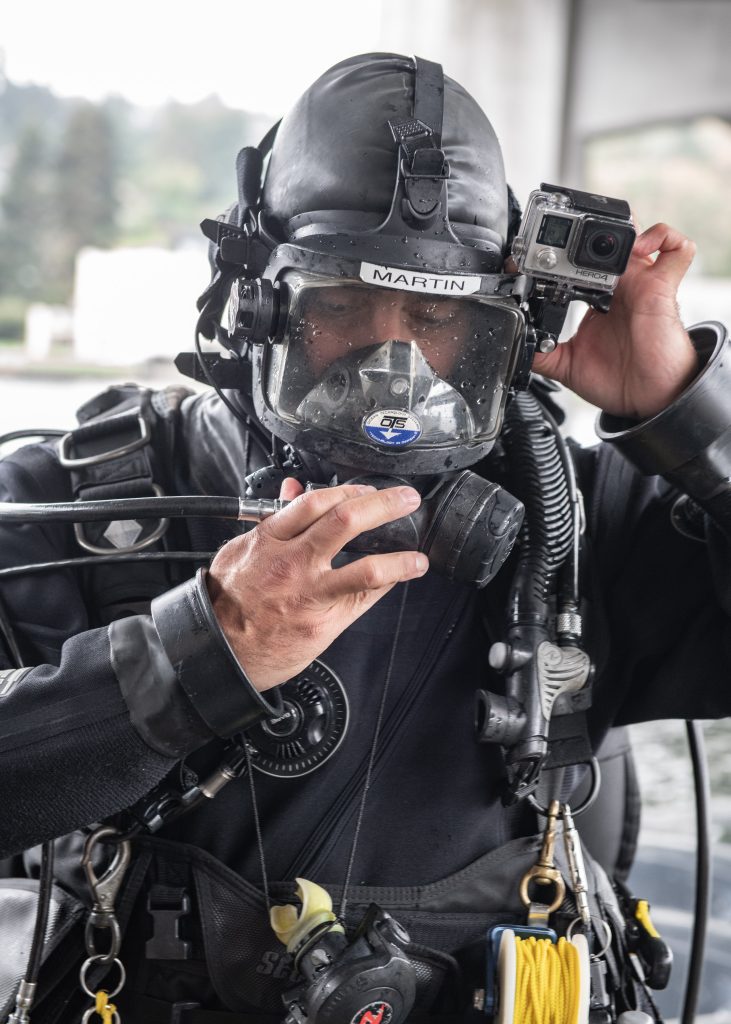
Seattle is known for its spectacular waterways, stunning shorelines, packed beaches, and enthusiastic boating community. Ensuring the safety of those who live, work, and play on our waters not only takes specialized equipment, but also a highly-skilled, multidisciplined team trained to respond to a broad array of water-related emergencies.
That’s where the Seattle Police Harbor Patrol comes in.
The Seattle Police Harbor Patrol is the only marine unit in the Pacific Northwest with 24-hour operations. Headquartered on Lake Union, Harbor Patrol covers 200 miles of City shoreline, 147 miles of freshwater, and 53 square miles of salt water, and responds to several thousand calls annually. In addition to providing marine law enforcement, rescue, and assistance, Harbor Patrol performs boat safety inspections, provides marine fire response and suppression, investigates water-related accidents and collisions, and much more. Harbor Patrol officers are excellent swimmers and certified SCUBA divers, tasked with both surface and dive search and rescue, plus evidence search and recovery.
Additionally, several Harbor Patrol officers are active SPD EMTs, and most have completed Advanced Marine Firefighting.
Your support of the Seattle Police Foundation has a tangible impact and helps make Seattle waters safer for those who live, work, and play here. Thank you!
The Seattle Police Foundation’s work to support Harbor Patrol is ongoing. Due to budgetary restrictions and staffing shortfalls, this unique and historic patrol unit needs our continued support. Please donate today to help preserve this lifesaving unit and maintain our life- and property-saving Harbor Patrol fleet.
To learn more about what Harbor Patrol does, please visit the Seattle Police Department Harbor Patrol webpage. To make a donation, visit our Harbor Patrol Unit donation page.

Meet the Fleet
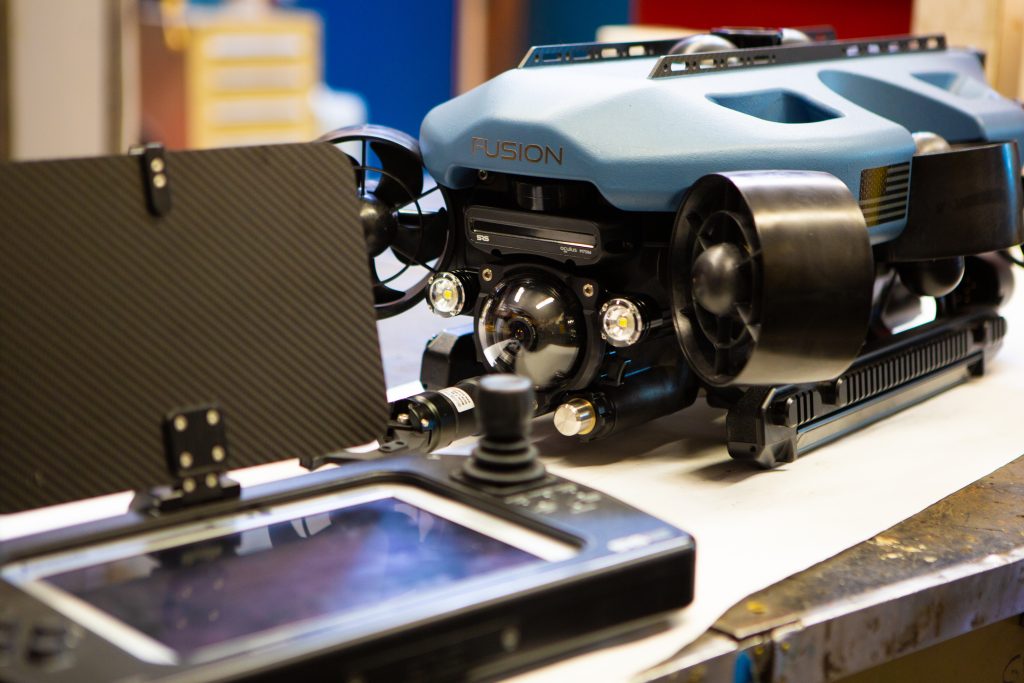
Harbor’s newest and most advanced ROV (remotely operated vehicle) is a FUSION, which was designed and built by a Redmond-based company called Strategic Robotic Systems (SRS). SRS specializes in next generation underwater systems for both military and law enforcement applications.
The sleek, lightweight ROV is a dramatic departure from the department’s legacy ROVs, which at one point were too heavy for one officer to lift without assistance. The FUSION is battery powered and can operate in different modes, including without the use of a tether. Typically, an ROV is attached with a cable, or a tether, that runs from the ROV to a control device, which is essentially a small computer with a screen for video output and a joystick-type feature to “drive” the robot.
The tether is how officers tell the ROV where to go and what to do, and how the ROV transmits data and images from underwater. In general, ROVs can only go as far as their tethers, which can be quite thick, and easily snagged on underwater obstructions. This is where the FUSION truly shines. Not only does it offer an autonomous (tether-less) mode, but it is powered by batteries, which means its tether/cable is very small in diameter, since its primary purpose is transmitting data, not power.
FUSION’s entire reel holds 1,640 (500 meters) feet of tether and weighs less than 30 pounds. The ROV itself weighs just 60 pounds, which is much easier to manage than the heavier ROVs of the past. The FUSION is equipped with forward-looking sonar, side-scan sonar, video camera, lights, and a grabber arm. The ROV’s thin-diameter tether offers several advantages, including increased mobility, better ease of use, greater range, and less pull as it travels through the water.
The design of its grabber arm is another improvement. The FUSION’s grabber arm offers more functionality and control than Harbor’s older (now backup) ROV, allowing for greater success recovering things from the water.
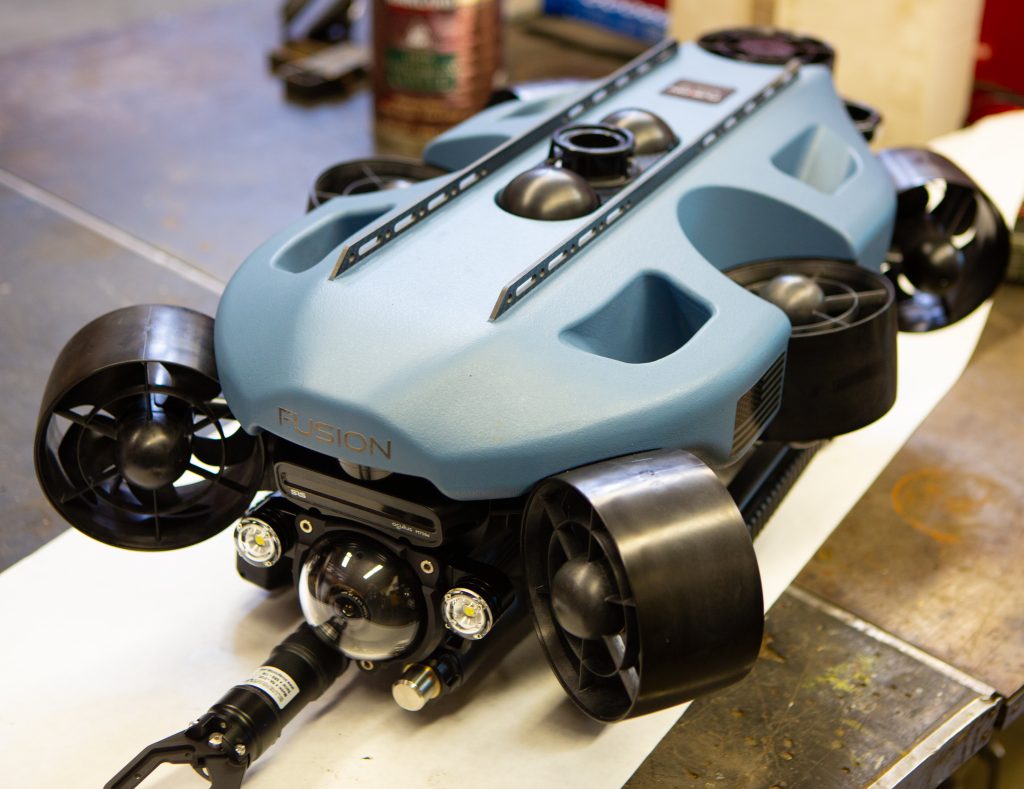 FUSION boasts a whole new level of versatility with its ability to operate as an autonomous underwater vehicle (AUV). Harbor officers can preprogram a search pattern and deploy the robot untethered, which is useful when conducting searches near and under the I90 and 520 bridges, where there are a variety of potential snagging hazards. When operating the robot in AUV mode, officers simply download the data and images captured during the mission once it comes back up to the surface.
FUSION boasts a whole new level of versatility with its ability to operate as an autonomous underwater vehicle (AUV). Harbor officers can preprogram a search pattern and deploy the robot untethered, which is useful when conducting searches near and under the I90 and 520 bridges, where there are a variety of potential snagging hazards. When operating the robot in AUV mode, officers simply download the data and images captured during the mission once it comes back up to the surface.
Missions can range in complexity, based on need. The robot is highly maneuverable, even in AUV mode. When it encounters an obstruction, it changes direction, and if it can’t clear an obstruction, it follows its preprogrammed instructions. In AUV mode, mission endurance is roughly three to four hours. In ROV mode (tethered), the robot can operate for over four hours depending on the conditions.
The robot has a second set of batteries, in case longer duration missions are needed.
The FUSION is an important asset that gives Harbor Patrol officers an invaluable way to search in the deeper waters of Lake Washington, Elliott Bay, and Puget Sound for objects beneath the water’s surface, and perform routine subsurface inspections of Harbor Unit buoy systems and other equipment. Fun fact: Harbor’s FUSION is a unique, steely color of blue, while most FUSIONs are red. That’s because Harbor’s FUSION was custom painted to match the original, pre-2015 Seattle Police Department uniform shirts, which were French blue.
SRS actually used one of the retired uniform shirts as a reference, to ensure an accurate color match.
Seattle police officers wore the two-toned uniforms for over 50 years, making it an important part of SPD’s history. We love the fact that the FUSION preserves the French blue tradition!
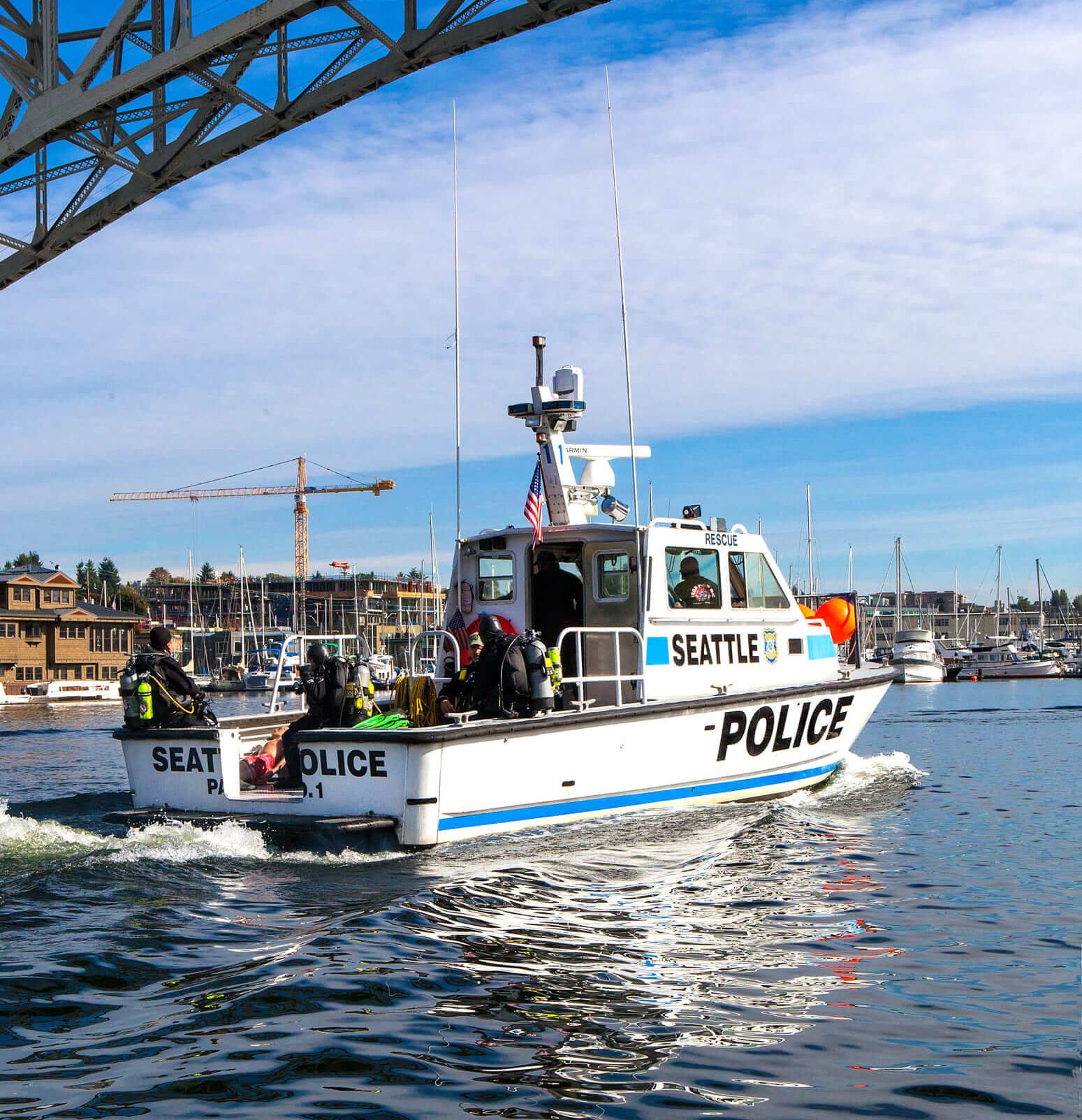
Patrol 1 is a 38-foot 1989 Munson Marine and is one of Harbor Patrol’s primary patrol boats. The vessel was refurbished in 2020 thanks to federal grant funding. Patrol 1 is used as a dive platform for search and rescue efforts, evidence searches, and recovery missions, and has the accommodations to remain on patrol in salt or fresh water for 12-plus hours at a stretch. It has a portable Hale fire pump, which can be used for dewatering or light firefighting. Patrol 1 is also used as a work platform for buoy installation and maintenance, and is capable of towing vessels and water hazards. It is equipped with a FLIR (Forward Looking InfraRed) and radar, for low light search and rescue, and has a hull-mounted Sonar, used to detect objects under the surface of the water.
Patrol 1 is frequently used for special events.
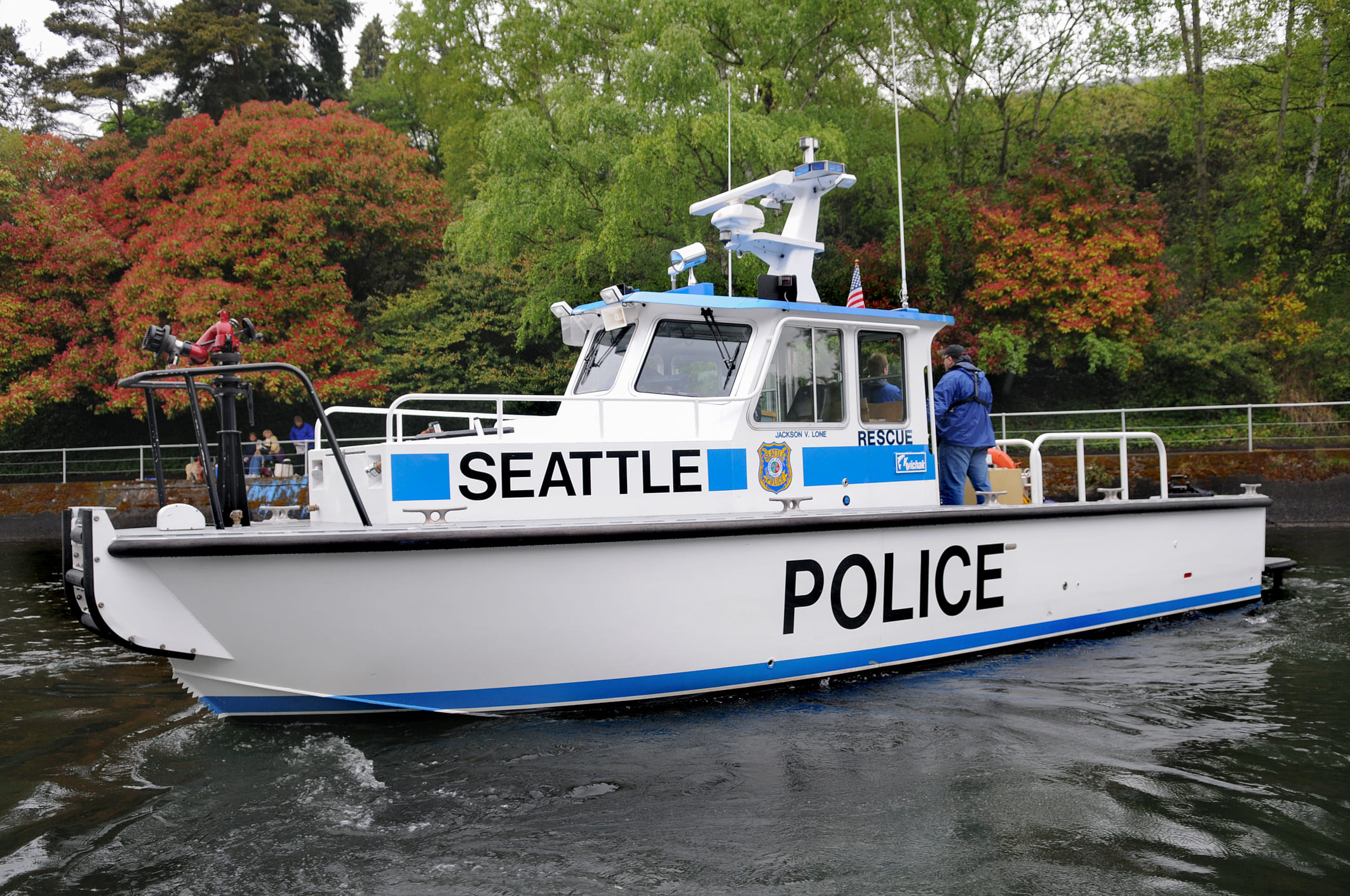
Patrol 2 is a 38-foot 2005 Kvichak Marine Industries. Its integrated 1,500 gallon-per-minute fire fighting water pump is currently out of service and is awaiting the funding needed to complete the repairs. Patrol 2 is extremely maneuverable due to its integrated jet propulsion system, making it optimal for navigating tight, boat-filled spaces like marinas.
Patrol 2 is used as a dive platform for search and rescue efforts, evidence searches, and recovery missions, and as a work platform for buoy installation and maintenance. It’s capable of towing water hazards and vessels, has a FLIR (Forward Looking InfraRed) and radar for low light search and rescue, and a hull-mounted Sonar for detecting objects under water. Patrol 2 has the accommodations to serve on extended patrol, staying out on the water for 12-plus hours at a stretch. It boasts twin 575 HP Caterpillar diesel engines and a HamiltonJet marine propulsion system. It has a portable Hale fire pump, which can be used for light firefighting and dewatering.
Patrol 2 bears the name Jackson V. Lone on its cabin in honor of fallen SPD Harbor Officer Jackson Lone, who died on March 16, 2005, after he fell in the water while working to secure a drifting tugboat. The new patrol boat was christened in Lone’s memory when it came into service in August of 2005.
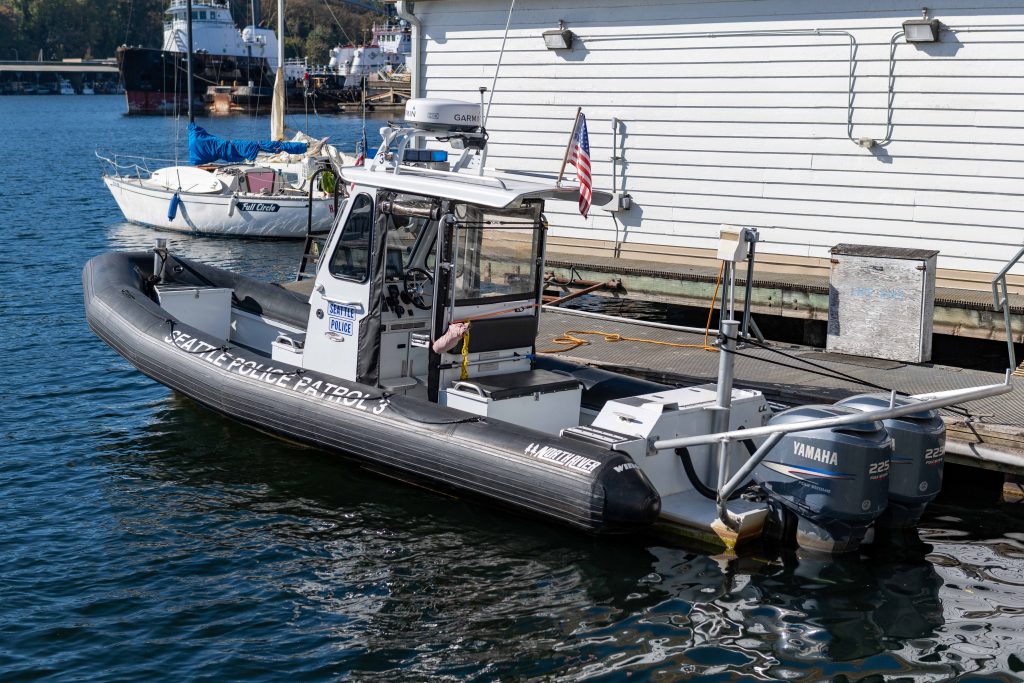
Patrol 3 is a 25-foot 2009 North River, built in Roseburg, Oregon. It is a rigid hull (aluminum) inflatable boat with a small, two-person cabin. Patrol 3 is used for fast response on both fresh and salt water, special event traffic control, and short-duration patrol. It’s highly maneuverable in small marinas and shallow water, has a fore and aft deck, and is an excellent surface rescue and recovery platform. During special events, Patrol 3 works in conjunction with a primary patrol boat.
The boat’s inflatable collar permits closer contact with other vessels, with less risk of damage. It has a very low wake – especially at high speeds – which allows emergency responses to Lake Washington or the Puget Sound with a lower chance of wake damage. It’s powered by twin 225 Yamaha outboards.
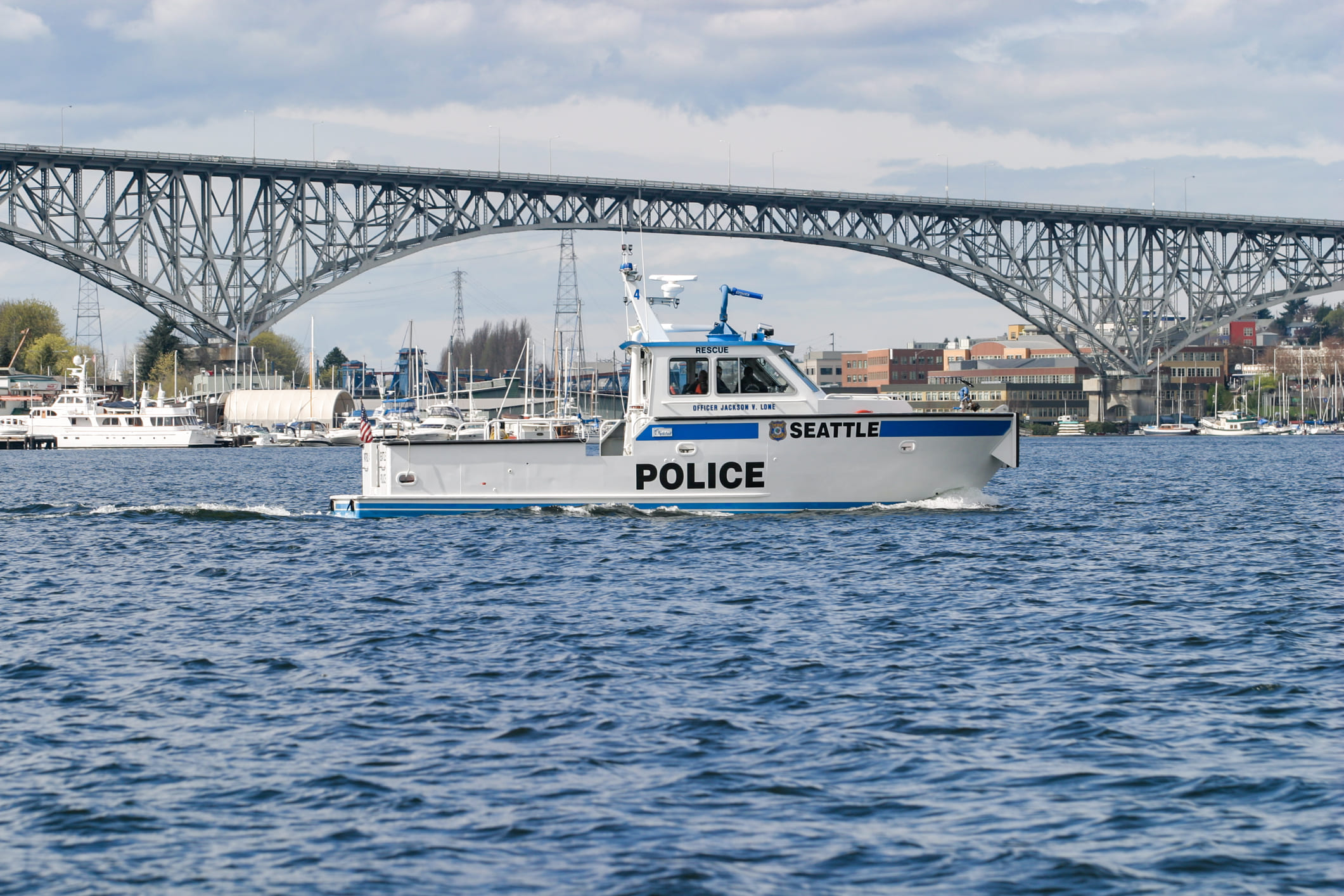
Patrol 4 is a 44-foot 1998 Kvichak Marine Industries and is one of Harbor Unit’s primary patrol vessels. It is a dive platform for search and rescue efforts, evidence searches, and recovery missions, offers significant large boat or structure firefighting capacity with an integrated 3,500 gallons-per-minute fire fighting water pump, and has firefighting foam capability.
Patrol 4 is a work platform for buoy installation and maintenance, and is capable of towing water hazards and vessels. It’s equipped with a FLIR (Forward Looking InfraRed) and radar for low light search and rescue, and a Sonar for detecting objects under water. Patrol 4 has the accommodations to serve on extended patrol, staying out on fresh or salt water for over 12 hours at a stretch. The boat is powered by twin 3196 660 HP Caterpillar diesel engines and has a third 3196 660 HP Caterpillar engine to operate the fire pump.
Patrol 4 is easily distinguishable by the bright blue monitor on the roof and the distinctive red monitor on the bow. Notably, Patrol 4 temporarily carried the name of Officer Jackson V. Lone on its side at Officer Lone’s memorial service in 2005. Officer Lone died on March 16, 2005, as he attempted to secure a drifting tugboat. Patrol 4 was Officer Lone’s primary patrol boat.
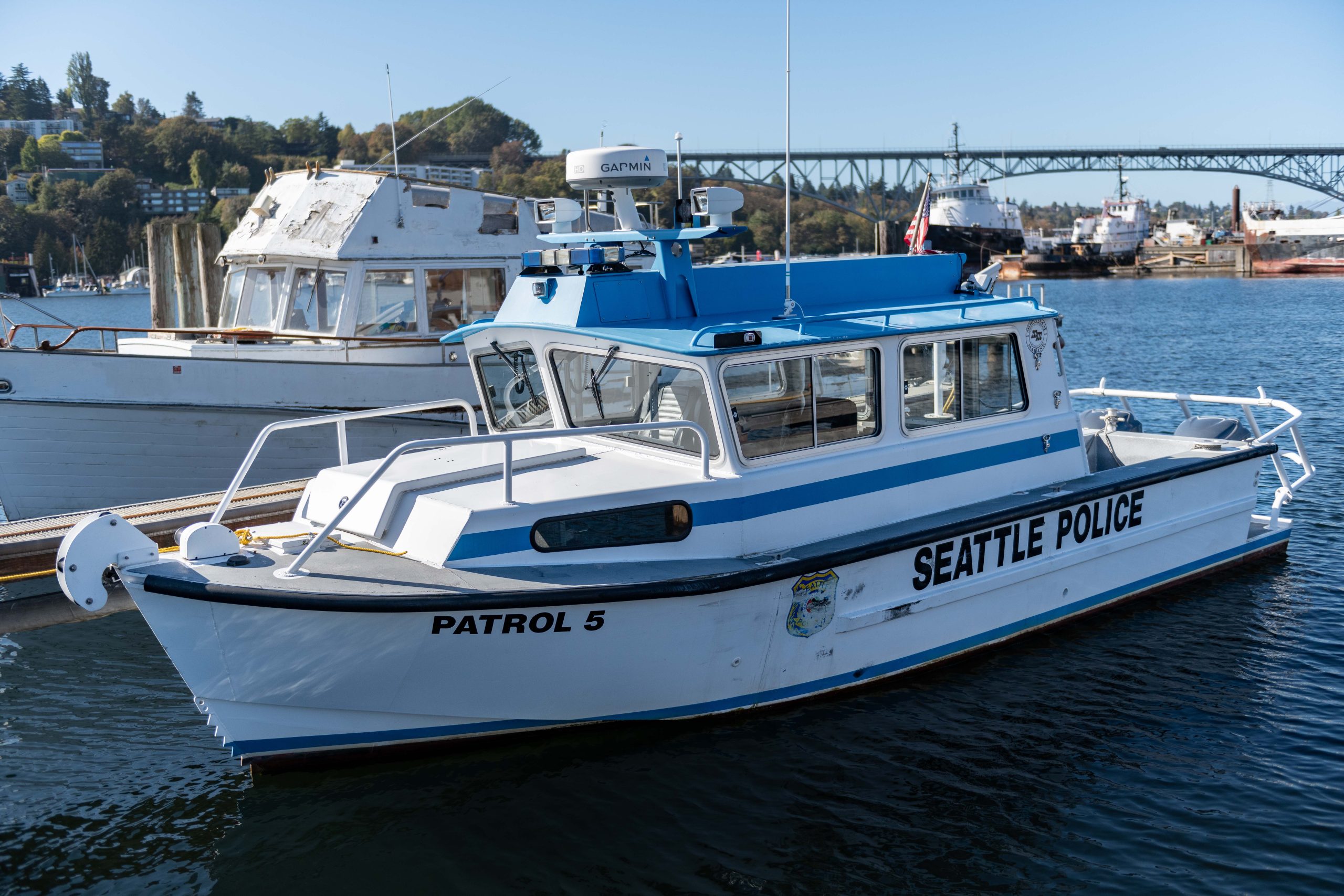
Patrol 5 is a 30-foot 2010 Modutech Marine. Known by the Unit as the “technology boat,” Patrol 5 can deploy in fresh and salt water, has a fully enclosed cabin, and has the accommodations to serve on extended patrol. It is a dive platform for search and rescue efforts, evidence searches, and recovery dives, and has a Remote Operated Vehicle (ROV/underwater robot) onboard for swift deployment during search and recovery missions. It has a Honda pump for dewatering sinking vessels and is a work platform for buoy installation and maintenance. It also has a side scan Sonar for enhanced underwater search and rescue efforts.
Patrol 5 is powered by twin 250 HP Yamaha outboards.
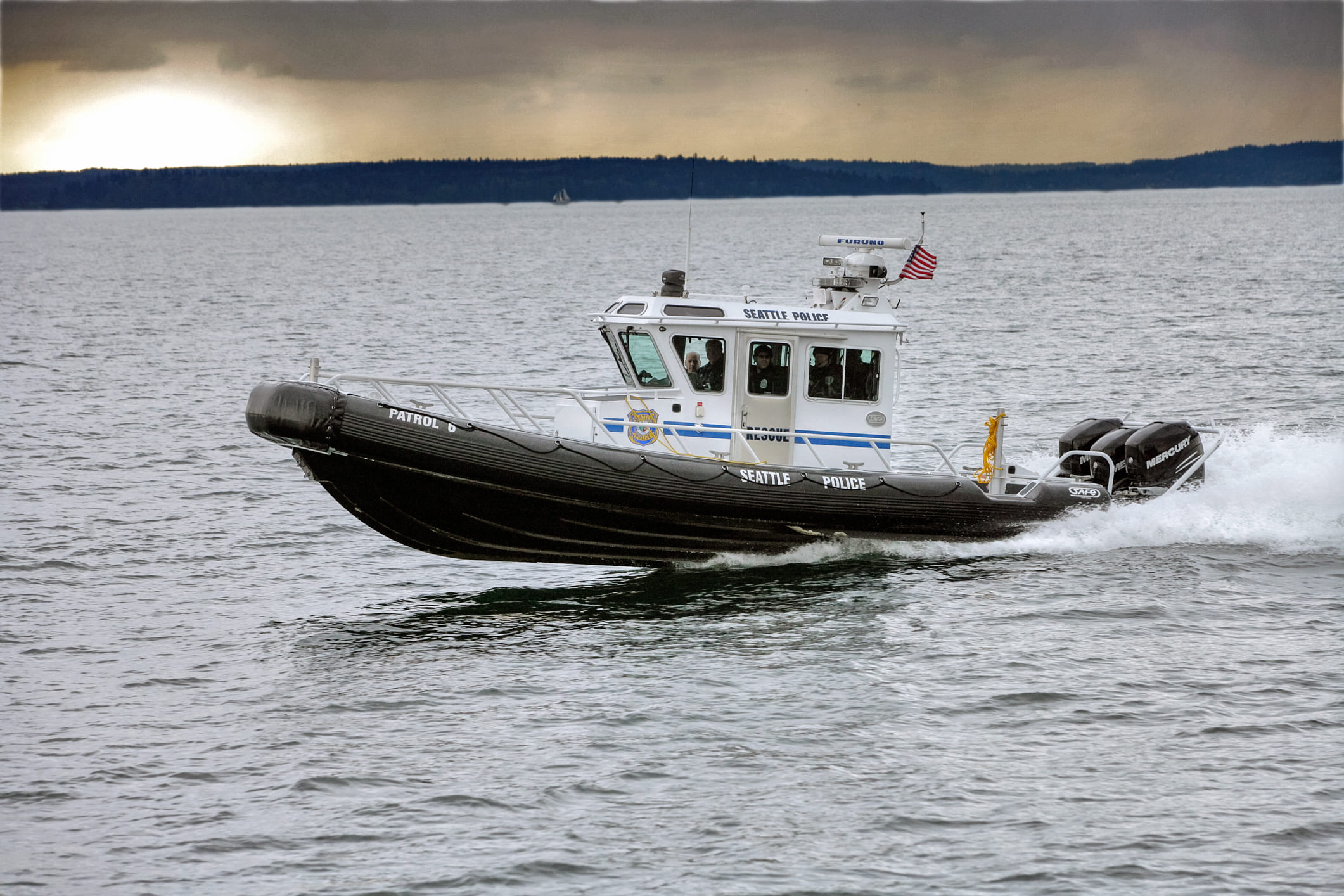
Patrol 6 is a 31-foot 2005 Safe Boat and is the fastest boat in our fleet! The rigid hull foam collar boat is excellent for rapid, emergency deployments. It serves as a short-term patrol boat and can respond in both fresh and salt water. Patrol 6 is highly maneuverable both at high speeds as well as in small marinas or shallow waters, has a fore and aft deck, a fully enclosed house, and is an excellent rescue and recovery platform. It has a FLIR and a radar for lowlight search and rescue missions and a hull-mounted Sonar for detecting objects underwater.
Patrol 6 often works in conjunction with a primary patrol boat at special events. Its foam collar permits closer contact with other vessels while minimizing the risk of damage and creates a very low wake – especially at high speeds – which allows emergency responses to Lake Washington and the Puget Sound with a lessened risk of wake damage.
This speedy watercraft is powered by three (3) 300 HP Mercury Verado outboards. Patrol 6 is routinely used in dynamic underway boarding exercises, in which SPD’s Special Weapons and Tactics (SWAT) Unit officers hone their skills at boarding another watercraft as it’s moving through the water.
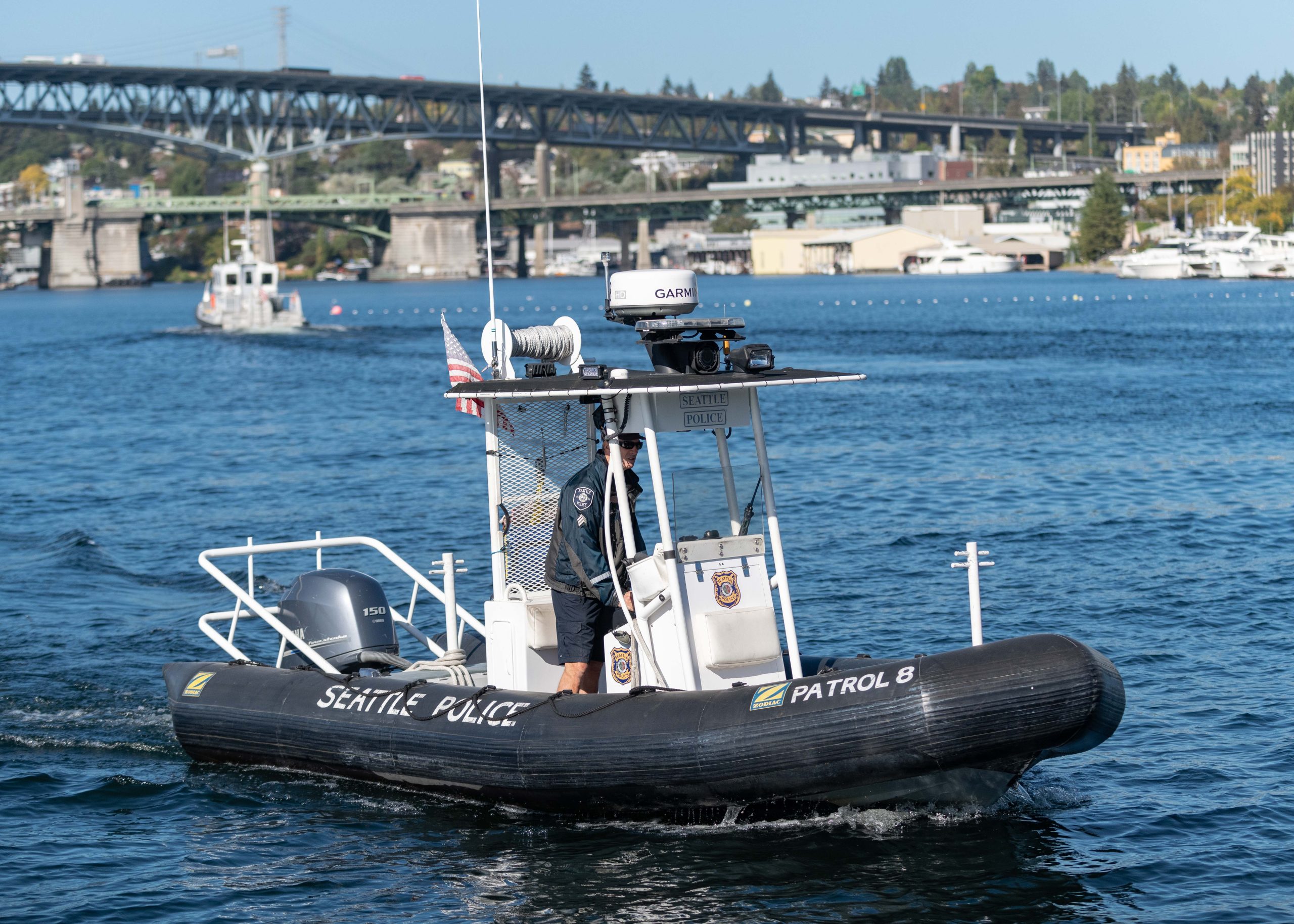
Patrols 7 and 8 are twin 21-foot 2013 Zodiac Hurricane rigid hull (fiberglass) inflatable fast response boats. Typically, one of these boats stays in the water, while the other one is trailered and poised for deployment to smaller bodies of water (local lakes) or other jurisdictions as needed. These rugged boats are the motorcycles of the Harbor Patrol fleet and are often used to stop speeders and address reckless behavior on Lake Union.
Additionally, they’re able to quickly respond to the bridges during crisis events including suicide attempts, and are also used as quick response scout boats for other water-based emergencies.
Patrols 7 and 8 are sometimes used as patrol boats for short-duration patrols.
They deploy in fresh water and are extremely maneuverable in small marinas and in shallow waters. They are excellent surface rescue and recovery platforms, are easily manageable by one Harbor Patrol officer, and often work in conjunction with a primary patrol boat at special events. Like the other rigid hull inflatables, the inflatable Zodiac hulls permit closer contact with other vessels with a lessened risk of damage, and they produce a low wake, even at high speeds.
Each is powered by a 150 HP Yamaha outboard.
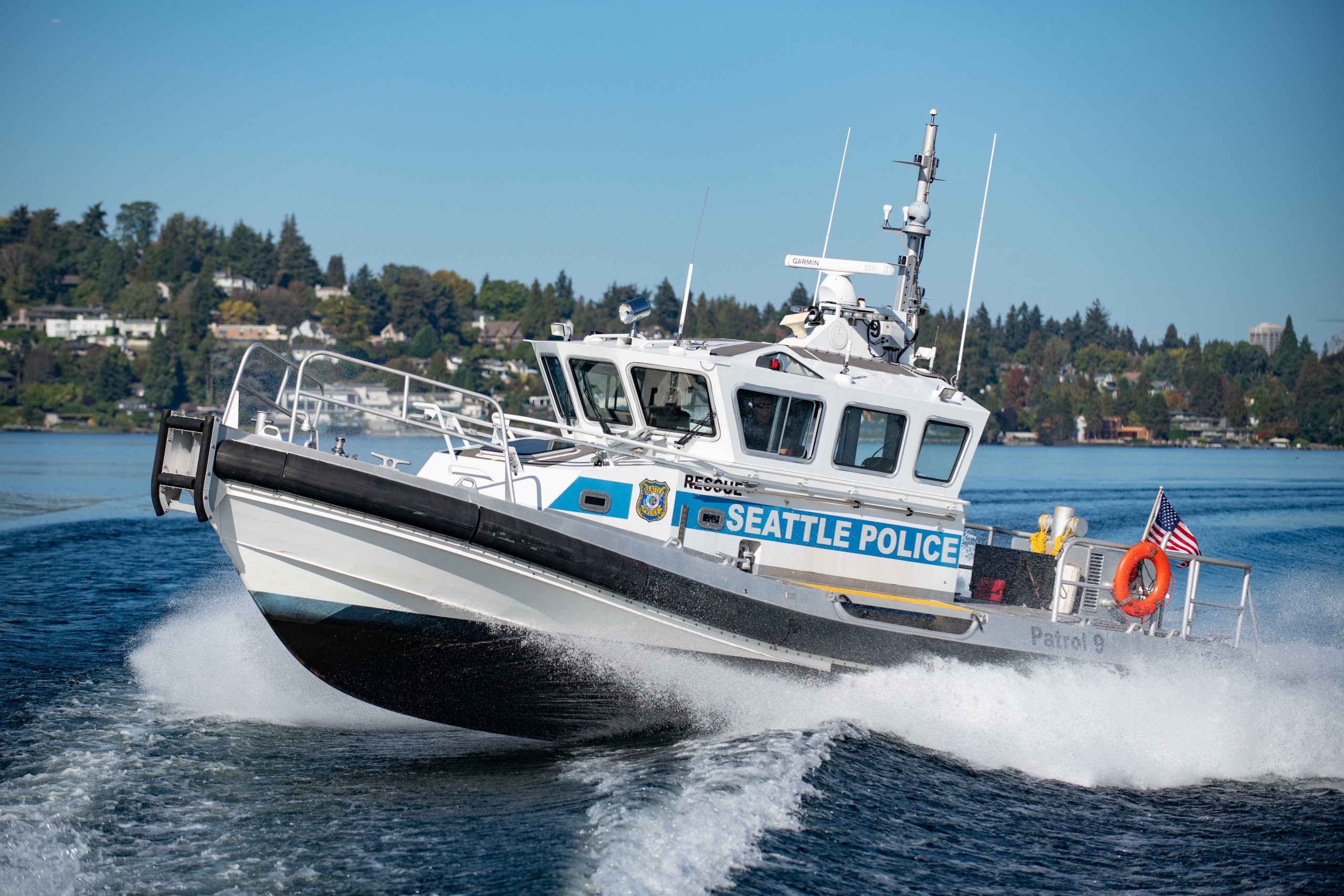
Patrol 9 is a 45-foot 2012 Kvichak Marine Industries and is used as a floating command post for natural disasters and/or major incident management. It is the same design as a Coast Guard Response Boat – Medium (RBM), and was adapted to meet Harbor Patrol Unit’s distinct needs. The boat was purchased with grant funding.
Patrol 9 is an excellent platform for Elliott Bay and the Salish Sea, and easily endures extended patrols on fresh or salt water, with the accommodations to stay out on the water for 12-plus hours at a stretch. The boat is controlled via a joystick and is highly maneuverable and relatively easy to captain considering its size. Its top speed is 40 knots, or around 46 miles-per-hour. Patrol 9 is the only vessel in the fleet with a marine heat/air conditioning system for extreme weather days.
It has a large rear deck workspace for search and rescue efforts, evidence searches, and recovery dives, and a long, flat front deck for observation and for addressing/communicating with larger vessels. It has a portable Hale fire pump for dewatering and light firefighting, and is a work platform for buoy installation and maintenance. It has a FLIR (Forward Looking InfraRed) and radar for low light search and rescue missions. It’s powered by twin Detroit Diesel Series 60s and two Kamewa Rolls-Royce FF-375S Waterjets.
Patrol 9 has key features that make it ideal for emergency law enforcement response and is used in dynamic SWAT training exercises that mimic high-risk hostage scenarios aboard a ferry. In these training exercises, SWAT officers are able to practice boarding a ferry boat while it’s traveling full speed across the water.
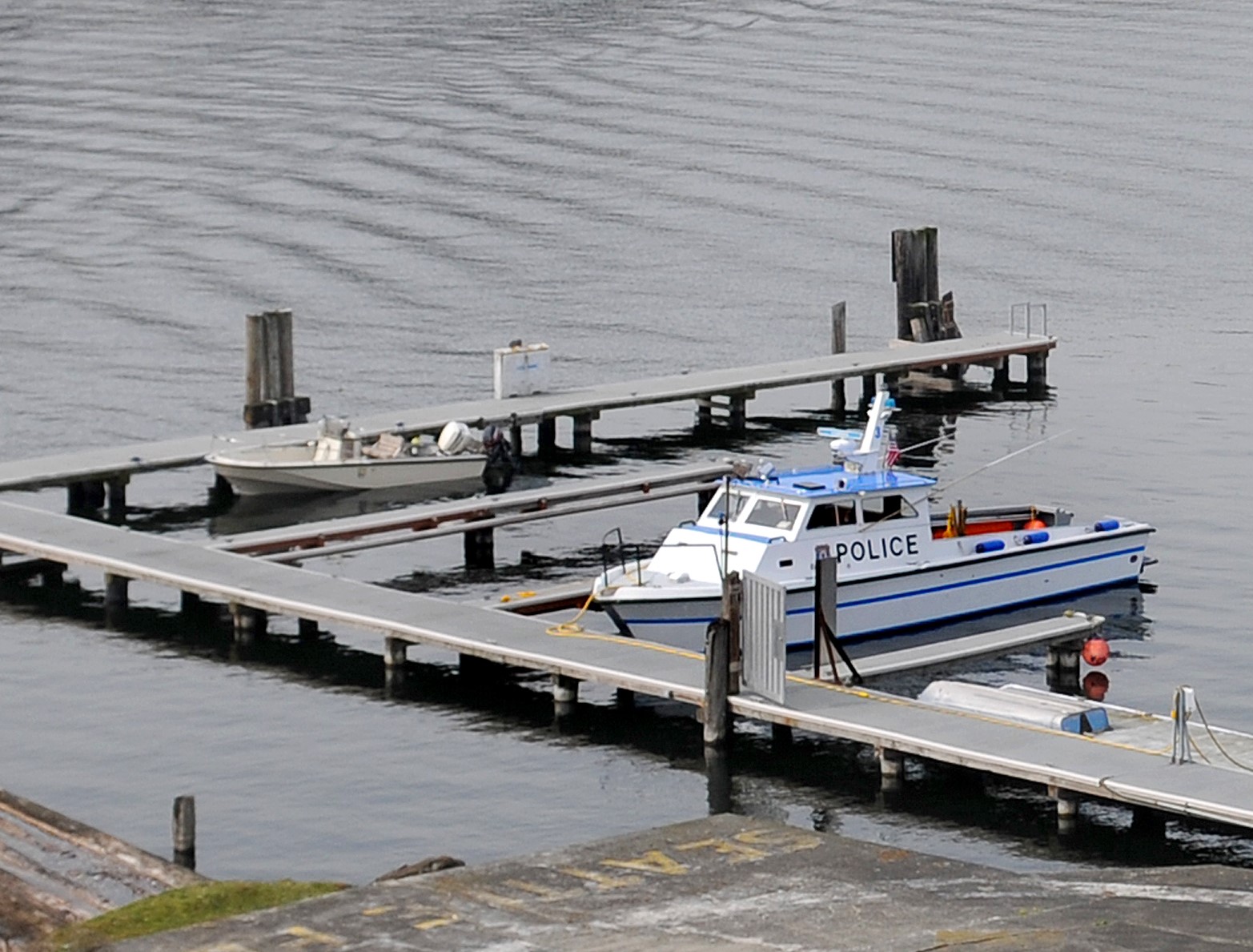
Patrol 16 is a 17-foot Boston Whaler, used in freshwater and near-shore deployments. The Whaler is great for getting into very shallow water, whether swampy areas or tight spaces immediately adjacent to City shorelines. It’s highly maneuverable and can access areas like the Arboretum, that the Harbor Unit’s other patrol boats can’t reach. It’s trailered most of the year but is easily towed to and deployed from City boat ramps. It’s powered by a 90 HP Suzuki outboard and boasts top speeds of around 40 knots. Patrol 16 is used during special events, especially 4th of July, for close-in patrolling of the Gas Works Park shoreline and the adjacent properties.
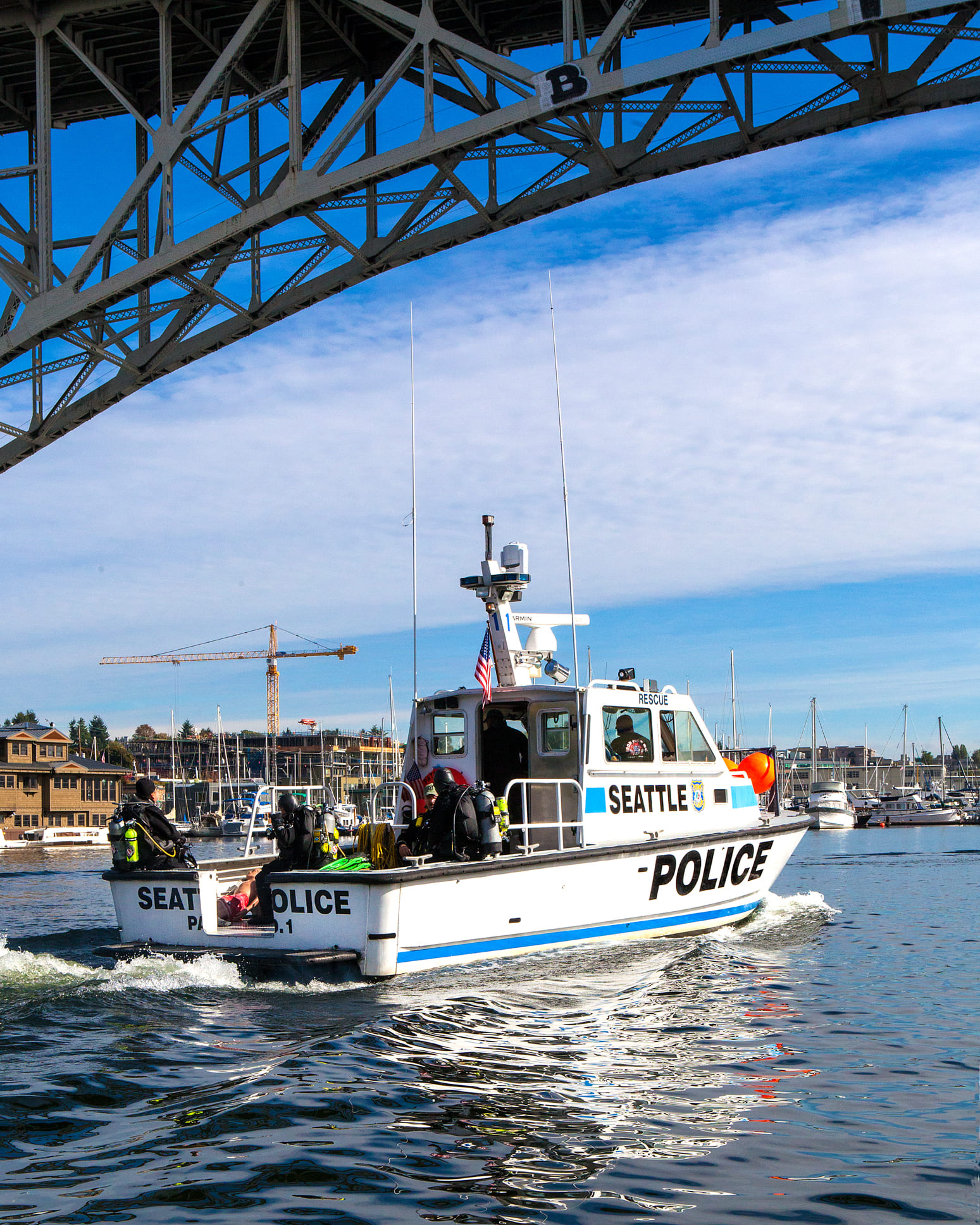
Patrol #1
Patrol 1 is a 38-foot 1989 Munson Marine and is one of Harbor Patrol’s primary patrol boats. The vessel was refurbished in 2020 thanks to federal grant funding. Patrol 1 is used as a dive platform for search and rescue efforts, evidence searches, and recovery missions, and has the accommodations to remain on patrol in salt or fresh water for 12-plus hours at a stretch. It has a portable Hale fire pump, which can be used for dewatering or light firefighting. Patrol 1 is also used as a work platform for buoy installation and maintenance, and is capable of towing vessels and water hazards. It is equipped with a FLIR (Forward Looking InfraRed) and radar, for low light search and rescue, and has a hull-mounted Sonar, used to detect objects under the surface of the water.
Patrol 1 is frequently used for special events.

Patrol #2
Patrol 2 is a 38-foot 2005 Kvichak Marine Industries. Its integrated 1,500 gallon-per-minute fire fighting water pump is currently out of service and is awaiting the funding needed to complete the repairs. Patrol 2 is extremely maneuverable due to its integrated jet propulsion system, making it optimal for navigating tight, boat-filled spaces like marinas.
Patrol 2 is used as a dive platform for search and rescue efforts, evidence searches, and recovery missions, and as a work platform for buoy installation and maintenance. It’s capable of towing water hazards and vessels, has a FLIR (Forward Looking InfraRed) and radar for low light search and rescue, and a hull-mounted Sonar for detecting objects under water. Patrol 2 has the accommodations to serve on extended patrol, staying out on the water for 12-plus hours at a stretch. It boasts twin 575 HP Caterpillar diesel engines and a HamiltonJet marine propulsion system. It has a portable Hale fire pump, which can be used for light firefighting and dewatering.
Patrol 2 bears the name Jackson V. Lone on its cabin in honor of fallen SPD Harbor Officer Jackson Lone, who died on March 16, 2005, after he fell in the water while working to secure a drifting tugboat. The new patrol boat was christened in Lone’s memory when it came into service in August of 2005.
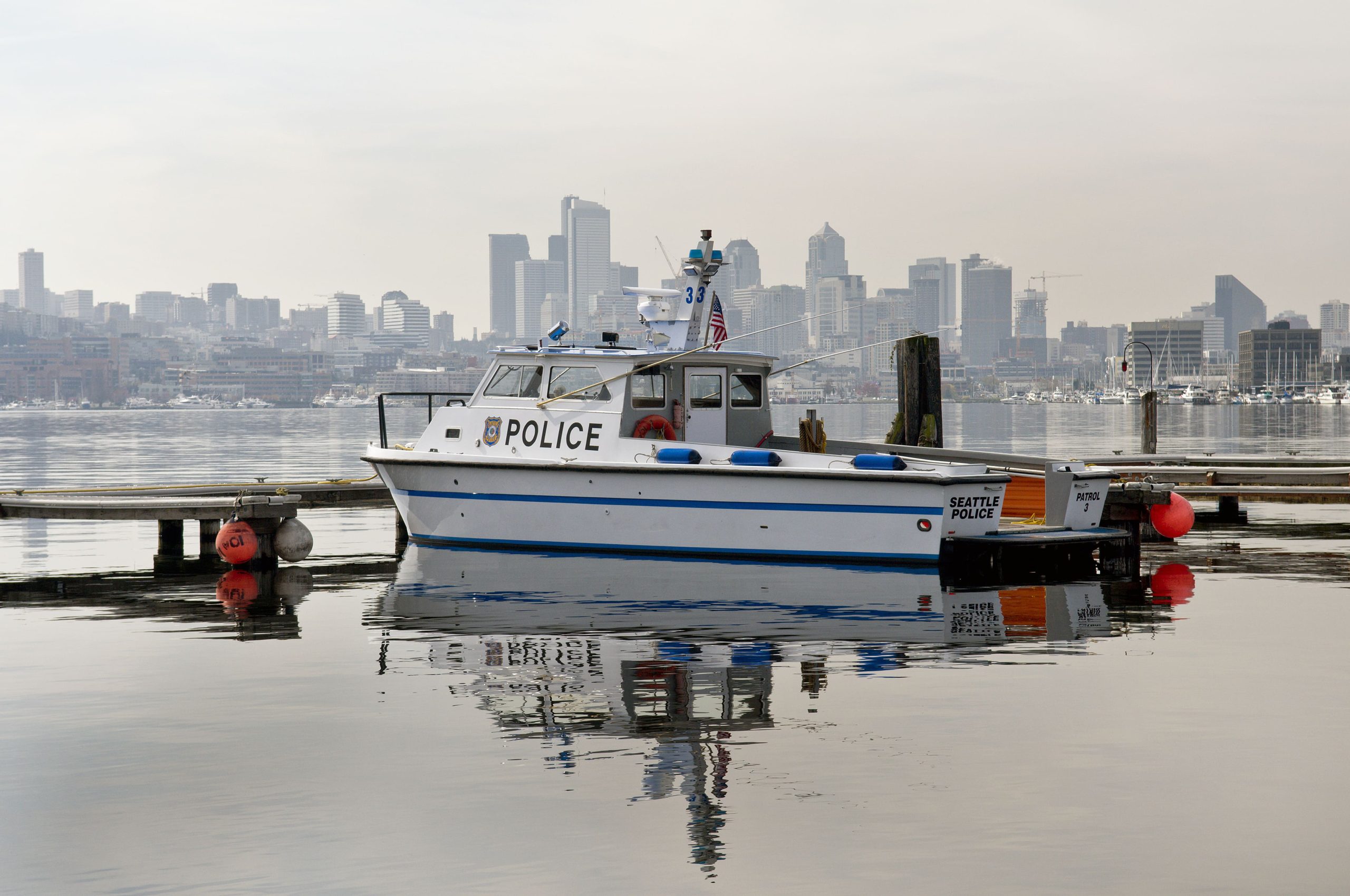
Patrol #3
Patrol 3 is a 25-foot 2009 North River, built in Roseburg, Oregon. It is a rigid hull (aluminum) inflatable boat with a small, two-person cabin. Patrol 3 is used for fast response on both fresh and salt water, special event traffic control, and short-duration patrol. It’s highly maneuverable in small marinas and shallow water, has a fore and aft deck, and is an excellent surface rescue and recovery platform. During special events, Patrol 3 works in conjunction with a primary patrol boat.
The boat’s inflatable collar permits closer contact with other vessels, with less risk of damage. It has a very low wake – especially at high speeds – which allows emergency responses to Lake Washington or the Puget Sound with a lower chance of wake damage. It’s powered by twin 225 Yamaha outboards.

Patrol #4
Patrol 4 is a 44-foot 1998 Kvichak Marine Industries and is one of Harbor Unit’s primary patrol vessels. It is a dive platform for search and rescue efforts, evidence searches, and recovery missions, offers significant large boat or structure firefighting capacity with an integrated 3,500 gallons-per-minute fire fighting water pump, and has firefighting foam capability.
Patrol 4 is a work platform for buoy installation and maintenance, and is capable of towing water hazards and vessels. It’s equipped with a FLIR (Forward Looking InfraRed) and radar for low light search and rescue, and a Sonar for detecting objects under water. Patrol 4 has the accommodations to serve on extended patrol, staying out on fresh or salt water for over 12 hours at a stretch. The boat is powered by twin 3196 660 HP Caterpillar diesel engines and has a third 3196 660 HP Caterpillar engine to operate the fire pump.
Patrol 4 is easily distinguishable by the bright blue monitor on the roof and the distinctive red monitor on the bow. Notably, Patrol 4 temporarily carried the name of Officer Jackson V. Lone on its side at Officer Lone’s memorial service in 2005. Officer Lone died on March 16, 2005, as he attempted to secure a drifting tugboat. Patrol 4 was Officer Lone’s primary patrol boat.

Patrol #5
Patrol 5 is a 30-foot 2010 Modutech Marine. Known by the Unit as the “technology boat,” Patrol 5 can deploy in fresh and salt water, has a fully enclosed cabin, and has the accommodations to serve on extended patrol. It is a dive platform for search and rescue efforts, evidence searches, and recovery dives, and has a Remote Operated Vehicle (ROV/underwater robot) onboard for swift deployment during search and recovery missions. It has a Honda pump for dewatering sinking vessels and is a work platform for buoy installation and maintenance. It also has a side scan Sonar for enhanced underwater search and rescue efforts.
Patrol 5 is powered by twin 250 HP Yamaha outboards.

Patrol #6
Patrol 6 is a 31-foot 2005 Safe Boat and is the fastest boat in our fleet! The rigid hull foam collar boat is excellent for rapid, emergency deployments. It serves as a short-term patrol boat and can respond in both fresh and salt water. Patrol 6 is highly maneuverable both at high speeds as well as in small marinas or shallow waters, has a fore and aft deck, a fully enclosed house, and is an excellent rescue and recovery platform. It has a FLIR and a radar for lowlight search and rescue missions and a hull-mounted Sonar for detecting objects underwater.
Patrol 6 often works in conjunction with a primary patrol boat at special events. Its foam collar permits closer contact with other vessels while minimizing the risk of damage and creates a very low wake – especially at high speeds – which allows emergency responses to Lake Washington and the Puget Sound with a lessened risk of wake damage.
This speedy watercraft is powered by three (3) 300 HP Mercury Verado outboards. Patrol 6 is routinely used in dynamic underway boarding exercises, in which SPD’s Special Weapons and Tactics (SWAT) Unit officers hone their skills at boarding another watercraft as it’s moving through the water.

Patrol #7 and Patrol #8
Patrols 7 and 8 are twin 21-foot 2013 Zodiac Hurricane rigid hull (fiberglass) inflatable fast response boats. Typically, one of these boats stays in the water, while the other one is trailered and poised for deployment to smaller bodies of water (local lakes) or other jurisdictions as needed. These rugged boats are the motorcycles of the Harbor Patrol fleet and are often used to stop speeders and address reckless behavior on Lake Union.
Additionally, they’re able to quickly respond to the bridges during crisis events including suicide attempts, and are also used as quick response scout boats for other water-based emergencies.
Patrols 7 and 8 are sometimes used as patrol boats for short-duration patrols.
They deploy in fresh water and are extremely maneuverable in small marinas and in shallow waters. They are excellent surface rescue and recovery platforms, are easily manageable by one Harbor Patrol officer, and often work in conjunction with a primary patrol boat at special events. Like the other rigid hull inflatables, the inflatable Zodiac hulls permit closer contact with other vessels with a lessened risk of damage, and they produce a low wake, even at high speeds.
Each is powered by a 150 HP Yamaha outboard.

Patrol #9
Patrol 9 is a 45-foot 2012 Kvichak Marine Industries and is used as a floating command post for natural disasters and/or major incident management. It is the same design as a Coast Guard Response Boat – Medium (RBM), and was adapted to meet Harbor Patrol Unit’s distinct needs. The boat was purchased with grant funding.
Patrol 9 is an excellent platform for Elliott Bay and the Salish Sea, and easily endures extended patrols on fresh or salt water, with the accommodations to stay out on the water for 12-plus hours at a stretch. The boat is controlled via a joystick and is highly maneuverable and relatively easy to captain considering its size. Its top speed is 40 knots, or around 46 miles-per-hour. Patrol 9 is the only vessel in the fleet with a marine heat/air conditioning system for extreme weather days.
It has a large rear deck workspace for search and rescue efforts, evidence searches, and recovery dives, and a long, flat front deck for observation and for addressing/communicating with larger vessels. It has a portable Hale fire pump for dewatering and light firefighting, and is a work platform for buoy installation and maintenance. It has a FLIR (Forward Looking InfraRed) and radar for low light search and rescue missions. It’s powered by twin Detroit Diesel Series 60s and two Kamewa Rolls-Royce FF-375S Waterjets.
Patrol 9 has key features that make it ideal for emergency law enforcement response and is used in dynamic SWAT training exercises that mimic high-risk hostage scenarios aboard a ferry. In these training exercises, SWAT officers are able to practice boarding a ferry boat while it’s traveling full speed across the water.

Patrol #16
Patrol 16 is a 17-foot Boston Whaler, used in freshwater and near-shore deployments. The Whaler is great for getting into very shallow water, whether swampy areas or tight spaces immediately adjacent to City shorelines. It’s highly maneuverable and can access areas like the Arboretum, that the Harbor Unit’s other patrol boats can’t reach. It’s trailered most of the year but is easily towed to and deployed from City boat ramps. It’s powered by a 90 HP Suzuki outboard and boasts top speeds of around 40 knots. Patrol 16 is used during special events, especially 4th of July, for close-in patrolling of the Gas Works Park shoreline and the adjacent properties.
Previous Harbor Fundraising Initiatives
For our 2023 fundraising, we focused on fire suppression safety gear and updated technology. The funding we raised will help pay for 16 new sets of bunker gear and other crucial marine fire suppression equipment, along with updated Forward Looking InfraRed (FLIR) thermal imaging systems for multiple vessels. All with the goal of helping ensure the safety of Seattle’s waters and shorelines throughout boating season and beyond.
FLIR Technology
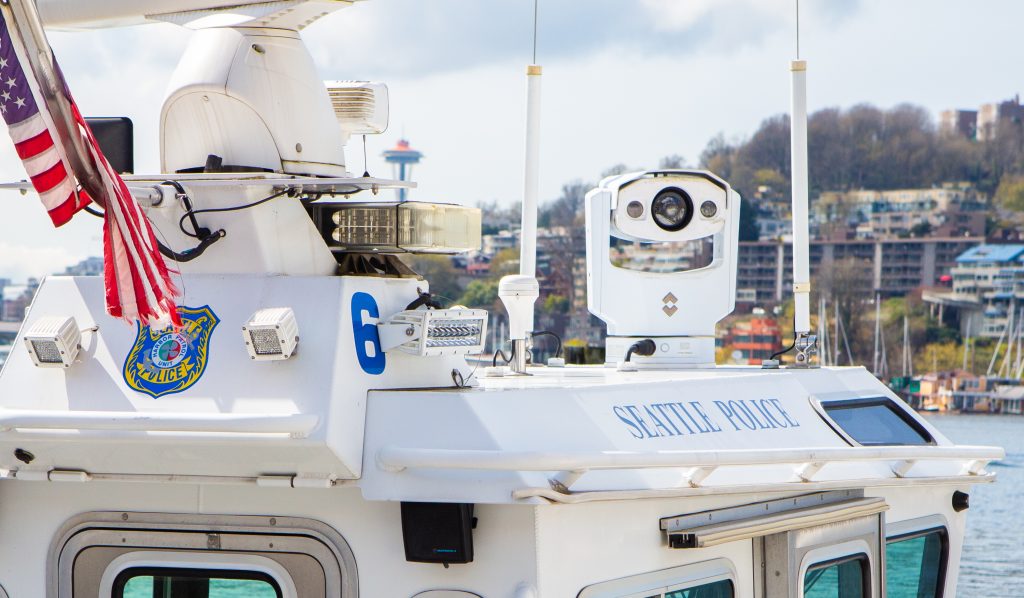 FLIR maritime thermal imaging systems give Harbor Patrol Unit officers the power to see clearly in total darkness, by converting heat into visible images. A FLIR can detect temperature differences as minimal as just one degree Fahrenheit and provide officers with an image of the heat source. FLIRs are primarily used for finding people and are a critical part of emergency rescue response.
FLIR maritime thermal imaging systems give Harbor Patrol Unit officers the power to see clearly in total darkness, by converting heat into visible images. A FLIR can detect temperature differences as minimal as just one degree Fahrenheit and provide officers with an image of the heat source. FLIRs are primarily used for finding people and are a critical part of emergency rescue response.
They are also useful in criminal incidents and can help locate suspects attempting to elude police by hiding in dark spaces under docks and in thick vegetation along shorelines.
Like with any technology, FLIRs need to be replaced periodically. Over time, these systems degrade, causing controllers to lose function and images to become less sharp. This degradation can negatively impact a FLIR’s ability to lock in on a target, which can mean the difference between life and death when trying to reach a swimmer in distress as rapidly as possible. Currently, the FLIR on Patrol 6 – the Harbor Patrol Unit’s fastest boat – has reached the end of its useful life and needs replacement. We hope to purchase a new FLIR for Patrol 6, and other cornerstone vessels as needed.
In addition to locating people in distress and criminal suspects, FLIRs can also aid in fire suppression. Officers can use the FLIR to scan the hull of a burning vessel to easily pinpoint hotspots, and in smoke filled environments to identify objects and locate survivors.
Fire Suppression
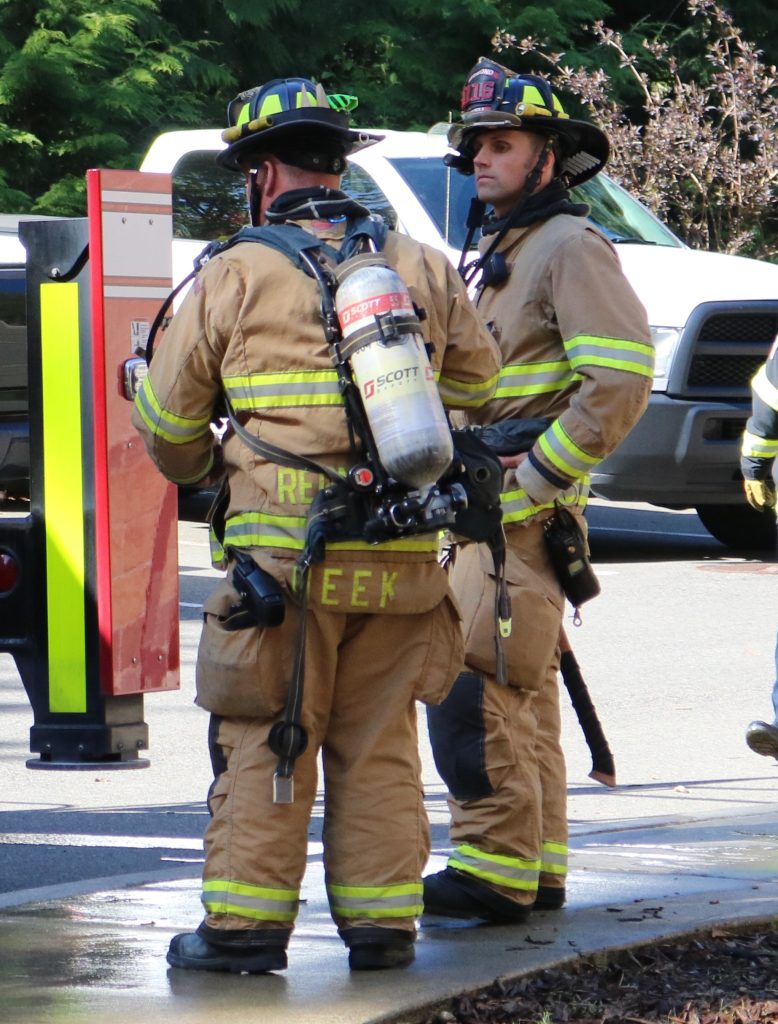 In addition to being the only marine unit in the Pacific Northwest with 24-hour operations, the Seattle Police Harbor Patrol Unit is the only public safety entity in our region that can enter a hot zone and begin fire containment efforts while law enforcement action is taking place. The ability to fight fires and prevent them from spreading is essential to the preservation of life, property, and evidence.
In addition to being the only marine unit in the Pacific Northwest with 24-hour operations, the Seattle Police Harbor Patrol Unit is the only public safety entity in our region that can enter a hot zone and begin fire containment efforts while law enforcement action is taking place. The ability to fight fires and prevent them from spreading is essential to the preservation of life, property, and evidence.
Proper personal protective equipment is mandatory for safe firefighting. Bunker gear (like what is shown in the photo to the right) allows Harbor officers to enter hazardous environments and conduct firefighting operations safely. It prevents injury, allows officers to remain in position longer, and ensures their ability to intercede and mitigate threats in fire-filled environments.
In March of 2023 a significant fire swept through a Portage Bay marina, destroying at least 30 boats. Seattle’s Harbor Patrol Unit was first on scene. We want to help ensure the safety of our officers while they’re rushing into dangerous situations on our waterways.
During the summer of 2022, the Seattle Police Foundation launched a successful fundraising initiative to help pay for indispensable repairs for Patrol 4, one of the largest of nine Harbor Patrol vessels. The boat was impaired by a bent shaft, which limited its speed to around 6 – 8 knots, or roughly 7 – 9 miles-per-hour.
Thanks to the generosity of our marine business community, friends, residents, and boating enthusiasts, we were able to exceed our goal of $25,000. Now repaired, Patrol 4 achieves speeds of around 32 knots, or just under 37 miles-an-hour, and is able to reach people who need help much quicker. Patrol 4 is critical to water safety in Seattle, and we are grateful for the community’s support.
The money also helped cover basic maintenance for the other Harbor Patrol boats.
